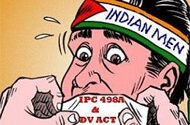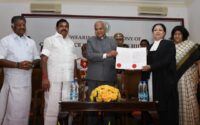Unconstitutionality Of Publishing Of Marriage Notices Under Special Marriage Act
This article is written by Pratha Waghmare, from University of Mumbai Law academy, Maharashtra and curated by Rajrishi Ramaswamy
Following allegations of misuse of personal information contained in the “Marriage Information” published by the Registration Department’s website, the Kerala government has issued a circular to stop the practice of uploading scanned copies of “planned marriage notices” submitted to the Undersecretaries. Although this part of the problem has been resolved, the larger part remains unresolved. Uploading of notifications has made it easier for “community groups” to misuse private information. But current laws do not prevent them to come to the registration offices and take a photo of the marriage notices published there and share them on social media.
Applicants submit the “planned marriage note” with the marriage officer and contain very personal details such as their name, address, age, occupation, photos and signatures. Section 6 of the Special Marriage Act, 1954 requires that the marriage officer maintain all these communications with his office records and immediately insert a true copy of each notice in the Book of Marriage Notices. This book will be open for inspection at any reasonable time, free of charge, to anyone wishing to inspect it. The law also requires the marriage office to publish each notice by placing a copy of it in a visible place in its office. If a party is not a permanent resident within the local boundaries of the marriage officer’s district, he must also send a copy of that notice to the district marriage officer within whose borders that party resides permanently and therefore to the marriage officer must put a copy somewhere visible in their office.
Therefore, if uploading marriage notices violates privacy of applicants, will it not be violated when published in an office open to the public? It is quite surprising to know that the constitutional validity of Section 6 of the 1954 Act has not yet been questioned by anyone so far.
Publication of the expected marriage notice
Section 6 of SMA is reproduced in its entirety below for easy reference:
- “Notices of marriage book and publication. (1) The marriage officer must keep all the notices referred to in section 5 with his office records and must also immediately insert a faithful copy of each notifi- cation in a book prescribed for this purpose. , will be called the Marriage Notice Book, and it will be open for inspection at any reasonable time, free of charge, by anyone who wishes to inspect it. (2) The marriage officer will have each notice published by placing a copy of the notice somewhere visible in his office. (3) When one of the parties to an intended marriage does not permanently reside within the local boundaries of the district of the Marriage Officer notified under section 5, the Marriage Officer will also arrange for it to be transmitted. A copy of this notice to the district marriage officer within whose borders that party resides permanently and that marriage officer must therefore send a copy to a prominent place in his office.”
This provision probably was included to enable matrimonial officers to verify the validity of a marriage. Essential pre-requirements include: (a) neither party has a living spouse, (b) neither party is unable to provide valid consent due to (i) mental weaknesses or (ii) has a mental issue or cannot procreate children, © ages of man and woman are 21 and 18 above respectively and (d) they do not fall under a forbidden relationship.
Interestingly, the marriage officer should conduct an investigation into the matter only if he receives an objection within thirty days. Objections raised to the wedding for any reason other than those mentioned above are irrelevant. Lack of consent from parents or relatives cannot be a reason for opposing a marriage under the SMA.
Discrimination against couples between religions
It is important to note that the Hindu Marriage Act and other personal laws relating to the solemnization of marriages do not meet the above requirements. To illustrate, a Hindu couple can solemnize their marriage without notice to any authority or public and register it later. This is the case with other personal laws. But for interreligious marriages, the law created an obstacle in the form of notices and publications. This is a clear violation of the doctrine of equality enshrined in Article 14 of the Indian Constitution, which orders the state not to deny any person, equality before the Law or equal protection of Law. It can be said that classification of individuals into interreligious couples and couples of the same faith and the application of different criteria to solemnize their marriages is legitimate or reasonable. Religion has little to do when it comes to choosing an individual as a life partner.
Breach of privacy
One of Justice D. Y. Chandrachud’s significant observation is that the privacy process must be considered before starting this discussion. According to him, privacy has both positive and negative content. Negative content prevents the state from committing an intrusion into a citizen’s life and personal freedom. Positive content imposes on the state the obligation to take all necessary measures to protect privacy of an individual. Therefore, the first question that needs to be addressed is whether the state intrudes on a citizen’s life and personal freedom by forcing the marriage officers to publish private details presented by people.
The Supreme Court in Shakti Vahini vs. UoI has stated unequivocally that when two adults choose themselves as life partners, it is a manifestation of their choice which is recognized in Articles 19 and 21 of the Constitution. Also in Shafin Jahan vs. Asokan KM, the Court observed that laws can prescribe conditions for marriage but cannot affect individual choices protected under the Constitution.
When an interreligious couple makes a request to the marriage officer, they expect them to respect their choice, obviously subject to compliance with conditions established by law. The Act requires matrimonial officers to publish the notices visible at some point in his office so that the public may object to him. If the goal of this requirement was to determine compliance with conditions, it was unnecessary to involve the public in the process. It would have been sufficient to authorize the marriage official to investigate the matter on his own or through his staff, in case he doubted that one of the parties did not comply with legal requirements. Another irony in the outline of the Act is that if no one opposes marriage, it does not require the marriage officer to conduct an investigation into it.
Especially after the 2017 privacy ruling, Parliament should have revised this requirement for publication of marriage notices. The ruling made clear that the right to privacy also imposes an obligation on the State to take all necessary measures to protect the privacy of a person. But it is too much to expect a revision by the legislators. It is sad that publication of marriage notices on websites began in Kerala long after the nine-judge Bench passed the privacy ruling. But it is encouraging to note that they corrected the error when it was reported. Now it is the Central Government that must take the initiative to review the Act with regard to Section 6.
Unjustified disclosure of marriage plans
Justice S. Ravindra Bhat, when he was a judge in the Delhi High Court, noted in his 2009 judgment [Pranav Kumar Mishra v. Govt. from NCT.] “It should be noted that the special marriage law was enacted to allow a special form of marriage for any Indian citizen, professing different religions or wishing for a civilized form of marriage. Unjustified disclosure of the marriage plans of two authorized adults to solemnize it can, in certain situations, endanger the marriage itself and, in some cases, it may even endanger the life or physical integrity of one of the parties to the interference of the parents “.
His observations on the “unjustified disclosure of marriage plans” are most significant in the times in which we live. Now it’s not just about interference from parents, but also from society. The advent of social media has taken the extent of interference to another level. Maybe because Section 6 was not contested and also because this sentence was issued long before the privacy judgment, the Judge did not consider the constitutionality of the provision which, in my opinion, is the issue with “unjustified disclosure of the marriage”.
In conclusion, I firmly believe that Section 6 of the Special Marriage Act, 1954 is unconstitutional and violates right to privacy under Article 21 of the Constitution for couples who choose interreligious marriages to the extent that it requires publication of their personal information. It also violates Article 14 as it discriminates against interreligious couples in exercising their right to choose their lifetime partners.


